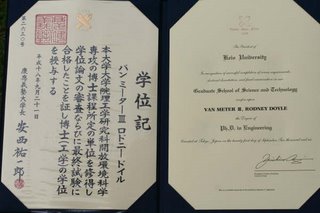Warning: Plot spoilersThis morning we went to see
"Gedo Senki", Studio Ghibli's anime film based on the third and fourth books of Ursula K. Le Guin's Earthsea series. (See
my earlier post for some useful links.) There are things to like about the film, but on the whole it's a bit disappointing, and I suspect that LeGuin won't really be happy with the result. (Indeed, after seeing the film, I agree pretty much completely with
her assessment.) It is a beautiful film, and has many positive features, but in some ways fails to capture the spirit of the books.
First off, it's important to note that the film is more violent than the books. If you're thinking about showing it to your young children, think again. This isn't
Totoro, it's more along the lines of
Princess Mononoke, which certainly has its rough spots. My seven-year-old daughter was rather taken aback, and I missed much of the last half hour of the film taking her out to the lobby and calming her down. It has always struck me as a bit odd that she (and others her age) can completely slough off the violence of "Pokemon" and various robot/mechanical anime TV shows. Of course, the big screen
is a different experience, and it didn't help that the showing started with ads for "X-Men" and some black comedy about a dead guy, but still. I think the main reason is that this film has a true emotional heart; she became involved with the characters, and cared about their fate, which isn't true for many of the violent superhero cartoons.
Mayumi, who hasn't read any of the books (though their Japanese translations are reportedly popular) found the film confusing. I was handicapped by language (I can still catch maybe only seventy-five percent of movie/TV Japanese, and the missing quarter is important), but somewhat helped by loving the books. However, it is many years since I have read the earlier books. Some of the sky scenes of a hawk, for example, are probably intended to represent Ged taking a hawk's form and spying on the evil sorceress, but are never explained. Likewise, the fact that Teru is in fact a dragon essentially turns up at the end, with little justification; we are vaguely given to understand early in the film that she is an unusual child, but Ged never pursues her nature and it is never explained. Most mystifyingly to non-initiates, the importance of true names is not adequately detailed, and the distinction between "Haitaka" and "Ged" is obscure.
The biggest problem with the film is that it turns Ged's quest to right what is wrong with the world, caused by misuse of magic, into a wizard-versus-wizard battle. In classic kid's film fashion, the kids have to rescue the adults in the end. Although the film has its quiet moments, the undoubtedly hard-to-film parts of the pursuit of knowledge suffer, and the thoughtful, emotional core of the books is hard to find in the film. Fixing the world, it seems to me, would allow for some great visuals, so I think they passed up a good opportunity there and misconstrued the spirit of the books at the same time. In this sense, it's like some of the things I disliked about
David Lynch's version of Dune, where an important practice or mystical power was reduced to a high-tech hand weapon.
Among the things I would have done differently, but don't necessarily dislike, are the color palette and the city design. Le Guin declines to comment on what race the various characters appear, citing uncertainty about how they appear to Japanese. My wife (who is Japanese), when I asked her what race Ged was, said, "Hmm, Norwegian? The city feels Roman..." The differences among characters are awfully subtle, and none appear to equate to Earthly dark-skinned islanders or Africans. Instead the correspond to what seems to be conventional anime types, rather than a stereotype-bending set of choices. The colors of the city and its design are not what I have in my mind's eye, but not necessarily wrong.
I think this film, standing alone, is reasonably successful, but I don't think it lives up to the source material. Like Le Guin, I would have been happier to see the father (Hayao) direct, rather than the son (Goro). It's a good first film from Goro, but a better script would have helped. Like all Ghibli films, it's visually rich and the music is powerful, but around Tokyo it's possible to be over-exposed to Teru's theme song.
Le Guin says it's tied up in rights trouble and won't be seen in the U.S. until 2009. Too bad, because it is worth seeing, despite the flaws. A subtitled version exists; it was shown to Le Guin. It wouldn't surprise me if that made it out to the gray market somehow before a fully-authorized version does.


